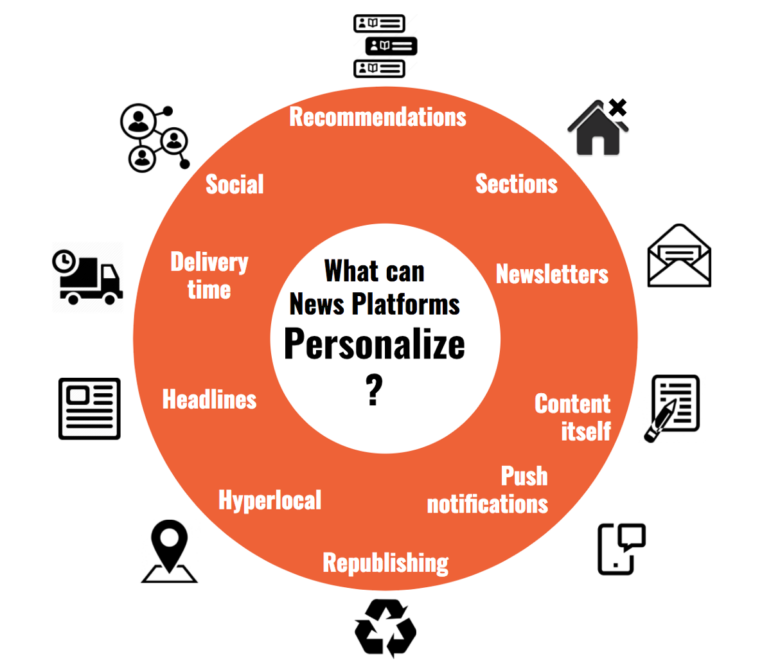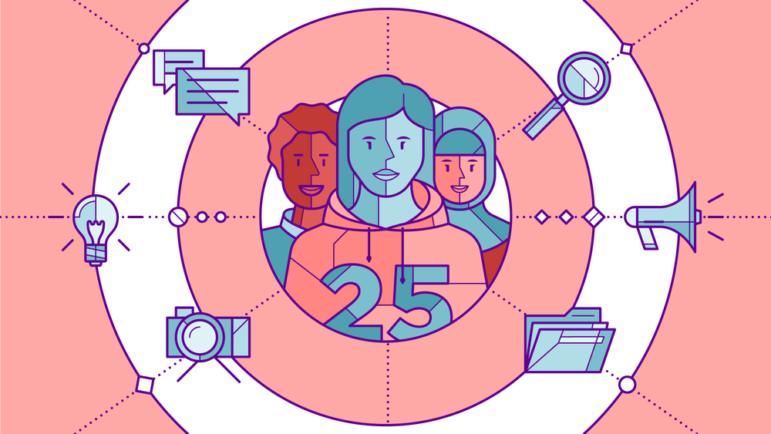

10 Ways to Personalize Your News Platform
 Most football fans don’t care that much about politics — but some do. There are also 14-year-old opera lovers; or grandmothers interested in self driving cars.
Most football fans don’t care that much about politics — but some do. There are also 14-year-old opera lovers; or grandmothers interested in self driving cars.
In the age of the information flood, selection and curation by trustworthy news organizations is more important than ever. But the audience is not a monolith. In fact, there are many different audiences. You can slice them down to segments, but if you look closely, those segments are in fact the sum of many individual behaviors, everyone different. The one-size-fits-all model is doomed to failure.
At the beginning of my journey as a John S Knight Journalism Fellow at Stanford University, I explained why personalization will be the next revolution in the news industry. The average online reader opens only 5 out of 1,000 stories published every day by larger news organizations. To better serve each user’s needs and eventually increase this poor ratio, I am convinced that personalization is key.
The car and furniture industries, for example, started with mass customization in the early 1990s. Recently, the music streaming and video industries deeply personalized their output. Imagine now a general news platform that can distribute the content that matters to each different reader, at the right moment, in the right form.
But if personalization is standard in other industries, it still represents a giant upheaval for journalists and editors. Nonetheless, a few news organizations, including some legacy news outlets, have taken first steps in that direction. Here is what these pioneers did and what could still be done.
1. Recommendation
The New York Times launched its first “Recommended for You” section in late 2013. Each user gets personalized recommendations, essentially based on their reading history. The Times neglected this idea for some years. But very recently the organization created a Personalization Team, with the goal to create a more user-centered experience. The team started with a brand new user dashboard. Now, one of its roles is to develop new machine-learning algorithms for its products. This should include recommendations, rankings, page generation and article selection, etc. It wouldn’t be surprising if at the end, the home page is different for each reader.
In the future, advanced personalized recommendation will not only be based on topics from your browsing history, but will take into account other signals such as:
- Type of stories you prefer (short and informative, interviews, long form).
- Places that matter to you (ZIP code, GPS).
- Time spent scrolling, and depth or shares.
- Tolerance for reading older news.
- Your personal interests.
- What affects you or your relatives and friends.
- Authors you like — or dislike.
The system should also integrate information from feedback loops, to continually improve it automatically. The Twitter user interface is a good example to follow on that point: If content does not seem relevant, you can precisely tell why in just two clicks. This feedback modifies the feed you will receive in the future.

Recommended: 1. BBC app with “My News” feed, 2. Tamedia’s “Flint” personalized recommender that performs 150 percent better than algorithms for the general audience, 3. NZZ Companion results.
At Tamedia, the Swiss news organization I work for, the personalized recommendation algorithm “Flint” has proven its effectiveness, with a click-through rate 2.5 times higher than with the recommendation engines designed for a general audience. The BBC News app has a “My News” tab.
The Neue Zürcher Zeitung, another Swiss newspaper, implemented an ambitious personalized recommendation engine, “NZZ Companion,” that tries to find a balance between predicted personal interests and the relevance of each story to the individual, as determined by the editors.
This is also the goal of the Content Personalization Network, which launched with media and technical partners from Germany, Belgium, Cyprus, Italy and Greece. By 2020, the consortium aims to build an open platform to allow new partners to personalize their user experience.
2. Sections
Instead of personalizing the news stream with highly complex algorithms, why not let users take control of their home page? This is the approach adopted by The Guardian’s new app; you can click on a topic tag to add it to your home page, and it becomes a new section.
Instead of having the traditional World, National, Business, Feature sections, the home page becomes fully customizable. Someone deeply interested in public health can create his own section, “Health Policy” or “NHS,” allowing these articles to surface there, even if they would appear in a subsection of the normal non-customized website. The BBC News app offers a similar feature.

Home: In The Guardian app, the user can choose a topic (1) and add it to the home page just by clicking on it (2 and 3).
The Guardian also lets you follow a particular reporter, and get an alert if she or he publishes a new piece. The French newspaper Le Monde has added this last feature for some topics, too.
The downside of active personalization is that only a minority of users understand and take time to customize their interface. This number is only 20 percent, at most, and can be as low as 2 percent, according to interviews I had with professionals from half a dozen different news organizations.
To turn around this well-known problem, tech companies have built very fluid onboarding experiences. Think about the 30+ clicks Apple is able to require from you the first time you launch Apple Music, in such a playful way that you wish this process could be even longer. Or think about how much information LinkedIn asks you for when you register.

Comfortable Customization: Apple has built an onboarding experience for it’s music streaming platform that gathers a lot of information from the user even before the first song is played.
News organizations shouldn’t be afraid to try the same tricks to get a lot of information from their users.
3. Newsletters
Newsletters have become a standard way to strengthen the relationship with the audience and eventually lead to subscriptions. But today, most of these newsletters are very impersonal.

Standard: The New York Times now has four versions of its “Morning Briefing,” but still no personalization.
The New York Times has launched Asian, European and Australian versions of its 6 am “Morning Briefing” for different time zones. Other news organizations go one tiny step further by addressing the newsletter with each recipient’s name. Of course, you can imagine a much deeper personalization, for example:
- Tailor the content or arrange the order and length, to better match the user’s needs.
- Deliver a targeted message to non-subscribers, with adapted special subscription rates to gain them as paid clients.
- Keep your customers, by explaining individually why their subscription is so important, and eventually upsell.
This kind of personalization should not exclusively serve marketing purposes but also have clear value for the audience side. Otherwise, it can quickly become creepy.
4. Push Notifications
The number of push notifications delivered on smartphones by news outlets has exploded in the past five years. For breaking news especially, media have implemented customization features. Some offer notifications by topic like “Politics,” “International” or “Culture.” Others give very specific customization possibilities, like news on your favorite soccer clubs. In some cases, the setting interface looks like a weird control center.
Again, the problem is that only a few readers make the effort to manage their notification settings. If they feel overloaded, they often decide just to turn off their notifications.

Push It: Three ways to manage notifications: 1. Expressen, Sweden ┆2. The Guardian, Great Britain ┆3. Le Monde, France
On average, only 40 percent of the installed news apps have notifications on, according to a recent international survey by Accengage, one of the big service providers in that field.
The next generation of notifications from news platforms should be automatically tailored to the user’s needs, based on their behavior. In other words, there would be a single smart push notification button. The system should also integrate a feedback loop. If I don’t care about this notification, I can tell it with a simple interaction.
5. Delivery Time
The best moment to access a story might be different from person to person. Some people have a lot of time in the mornings and afternoons, because they commute an hour or two every day, others are not as receptive. Why should news organizations waste their efforts promoting a long-form story that took months to investigate, by offering it only once for everyone? And then letting the next 1,000 stories wash it away?
The Guardian is experimenting with its LabRdr news app, which delivers offline articles personalized for users during their commute time. Just before your usual commute starts (and you go down on the subway, with poor network), the app downloads a package of stories you might read, based on your location and the topics you prefer.

On Time: The Guardian’s experimental LabRdr app delivers offline articles personalized for your commute time.
The Swiss NZZ algorithm prepares three different buckets for you: stories for the morning, for the evening and for the weekend. These are just attempts. Maybe there are simpler and more effective ways to adapt the news flow to each user.
6. Republishing
There are a lot of hidden treasures in the archives of news organization. In the digital age, it should be much easier to surface them.
The Swiss newspaper Le Temps has developed a very interesting algorithm named “Zombie,” which recommends a daily list of articles from the past that fit again in the news cycle. The “evergreenness” of the articles is calculated automatically, based on indicators such as clicks and shares over time. The final curation is done by humans. Recently, for example, “Zombie” reanimated a six-year-old vitriolic article about the sexist use of young women at the Geneva international auto show.
If fully automated and tailored to each individual reader, this approach could be used much more aggressively. In feature sections that are less news dependent, this could bring substantial savings: a higher user satisfaction could be induced, even with a slower input flow.
7. Hyperlocal/Special Interest
Thanks to personalization, the investment in local or even hyperlocal news could be interesting for larger players. With a group of five or six reporters, you can do a pretty good job in a midsize US city, let’s say Boise. Their production would be displayed on the home page of readers in Idaho. If paid subscriptions to your national news platform grow enough in this area to finance these reporters, you have won.
Automatically generated content or at least automatically discovered content could help address tiny audiences cost-effectively.
The same strategy could be deployed for special-interest segments. In the end, news organizations that are able to correctly use this type of personalization could develop a long-tail audience.
8. Headlines and Images
Some news organizations already do A/B testing on headlines. The Washington Post goes one step further: “We encourage our newsroom to do as many headlines, images and blurbs as possible,” explained their chief of product and chief information officer, Shailesh Prakash, at the 2017 Computation + Journalism Symposium at Northwestern University.
The internally developed tool “Bandito” looks at which combination is winning, and gives it more traffic. This approach is then spliced and diced down by user segments (international audience versus US audience, women versus men, India versus Canada, etc.). At the end, different users get different headlines for the same content.

Winning: The Washington Post’s “Bandito” dramatically improves the click-through rate on stories, scaled thanks to automatically generated headlines.
Some of those headlines are now generated by algorithms using multi-sentence compression or neural machine translation. The Washington Post winning machine works at scale.
9. Content Itself
Beyond headlines, the content itself can be tailored for each reader. In just 10 weeks, my team in a journalism class at Stanford developed a prototype of a writing tool that makes this possible for nearly every article. In the next iteration for a Lean Launchpad class, we figured out how to inform writers about their audience, still during the writing process. We used reader data to identify segments of users with a stronger relationship to the article. With this information, the journalists can then tweak the content for those reader archetypes. The idea is to double down where this extra effort is worth it, either from a subscription or an ads perspective.
For each kind of personalization — but particularly for this approach — transparency, reproducibility and traceability are key.
- It must be clear that this content has been personalized, based on these variables.
- Each user must be able to share exactly the content he received, even if the recipient of the “share” has other characteristics.
- Logs of all versions that have been shown might be necessary in certain contexts.
10. Comments and Shares from Friends
Smart news aggregators like Nuzzel or Refind lean on social network recommendations. The user can see who of his friends has opened or shared a particular news piece.
If these startups are able to convince users to link to their Facebook, LinkedIn or Twitter profiles, news organizations should try the same move. Instead of seeing that the piece about “The Secret Life of the City Banana” received 140 comments, you would see that your friend Jake has commented it. Or that your other friend Catherine shared it.
This simple trick would add a completely new dimension to the comment section, and eventually turn it into a conversation, both in the digital and the physical world.
Some people only like to comment in a safe environment; it would be easy to show some comments exclusively to your friends. Instead of sharing their feelings about news on Facebook, the users would have this possibility without leaving the news platform.

Sharing is Caring: You can see what your friends friends have seen: 1. Nuzzle ┆2. Refind ┆3. Google News
Another advantage would be that if enough readers link their profiles, you can add this social network layer to your recommendation algorithm. This would be particularly useful for situations with fewer data points.
Finally, adding a social network component could also rekindle the social status symbol function of being a subscriber. Like in the past when you would deliberately “forget” a paper edition of your newspaper in the living room or on your desk, you could show in the digital space that you belong to the readers of this particular news outlet.
News organizations can accomplish this journey towards a fully personalized user experience. Considered individually, most of these steps have already been implemented by somebody and proven successful.
User-centered design, experimenting in small bricks with rapid prototypes and measuring success or failure with clear metrics, are essential.
At a time when more and more news outlets are shifting from an advertising-based revenue model to a subscription based model, personalization is the best way to reinforce the relation to the real client: the reader. The best journalism deserves that.
This post first appeared on Titus Plattner’s Medium page and is cross-posted here with permission.
 Titus Plattner is an investigative reporter and a JSK Fellow at Stanford University (2017-2018). Previously, he worked on the investigative team of two Sunday papers in the French and German parts of Switzerland, Le Matin Dimanche and SonntagsZeitung. Plattner has been part of the Swiss team on ICIJ projects since 2013.
Titus Plattner is an investigative reporter and a JSK Fellow at Stanford University (2017-2018). Previously, he worked on the investigative team of two Sunday papers in the French and German parts of Switzerland, Le Matin Dimanche and SonntagsZeitung. Plattner has been part of the Swiss team on ICIJ projects since 2013.











